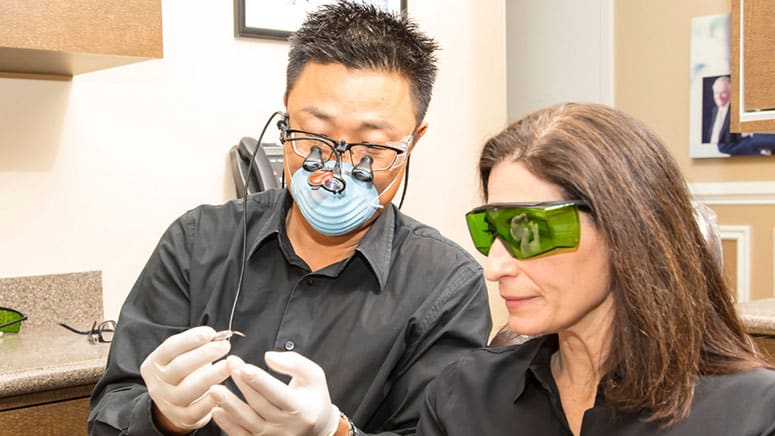
Endodontics treats the pulp and other tissue inside your teeth. Endodontic therapy is often referred to as a root canal. It can preserve your natural tooth even when the inside of your tooth has become decayed and damaged.
Put An End To Pain With A Root Canal
We have all heard horror stories about root canals, but when done properly by a qualified dentist, endodontic therapy does not to have to be painful. In fact, if you need the procedure you are probably in pain right now. Endodontic therapy can put an end to that pain.
If you do have anxiety about dental visits, Dr. Chung offers sedation dentistry to help you relax and have a pleasant, comfortable experience. Please call Softouch Dental Care today at 703-319-6990 if you're experiencing tooth pain. Our experienced dentist proudly serves patients in Oakton and surrounding communities.
Understanding The Root Canal
Inside the visible part of a tooth (the crown) is a space known as the pulp chamber. It extends down inside the tooth roots right to their tips in the jawbone. This is where blood vessels and nerves enter the teeth from the body’s circulatory and nervous systems. Because it’s the tooth’s root that contains this long chamber, it’s known as the root canal. There may be up to four roots per tooth, each with a root canal.
What we call “pulp” consists of the small blood vessels and nerves, plus fibrous connective tissue. Bacteria can enter the pulp through decay that has broken down part of the enamel or through a crack in the enamel.

When bacteria get inside the pulp, infection spreads and reaches the nerve inside that root canal. When the nerve is subjected to bacterial toxins and infection, we have a toothache. When the nerve finally dies, that toothache disappears, but the problem continues.
Decay, if left untreated, can spread right down the root canal into the jawbone. Since there are blood vessels in the root canal and gums, infection can get into the bloodstream and thus travel to any other part of the body.
How Endodontic Therapy Works
If the problems are treated early enough, the tooth root can be saved. Dr. Chung can do this by cleaning out the bacteria, their debris, and all infected material from the tooth and root canal, and then filling it with dental materials. By the time the root canal needs saving, the tooth’s crown is already past saving and will need a crown.
During endodontic treatment, Dr. Chung will fill the root canal with a rubbery substance called Gutta Percha and place a porcelain crown over the remaining tooth structure. He will then seal off the tip of the root to prevent any leaking.
You now have a newly reinforced tooth with no nerve. The porcelain crown part of the tooth looks, feels, and functions like your regular teeth. The nerve’s absence means you will have no more toothaches in that tooth, and does not compromise the tooth in any way. It can exist indefinitely without any nerve, allowing you to chew normally and painlessly again. You will be able to go back to eating your favorite food in comfort, and the procedure will not affect how you speak.

Who is a candidate for a Root Canal Procedure?
Root canal may be appropriate for any patient who has experienced severe tooth damage. Usually, infection develops in the pulp chamber as a result of an untreated cavity. However, a direct injury to a tooth could also cause intense or ongoing pain. It is important to address a toothache as soon as possible to prevent extreme infection, abscess, and tooth loss. Root canal therapy is a conservative endodontic procedure that quickly resolves a toothache and restores integrity to the damaged tooth.
How long does a Root Canal Procedure take?
The root canal procedure can take 60 to 90 minutes. It may take a few minutes to complete necessary forms beforehand and schedule the next appointment for the application of a dental crown over the treated tooth.
Does a Root Canal require anesthesia?
Root canal procedures are performed using the same local anesthetic that numbs the mouth for a dental filling. Dosing of the anesthetic may differ slightly due to the length of the procedure. Additionally, some patients choose to have their root canal while sedated. Sedation dentistry options include nitrous oxide, which is delivered throughout the procedure, and oral conscious sedation, which is a pill that is taken about an hour before we begin treating the tooth. With or without sedation, patients are kept comfortable during their root canal. There is no pain, only sensations of pressure as the dentist clears infection from the center of the tooth.
What is the recovery process like after a Root Canal?
Once anesthesia wears off and the mouth is no longer numb, patients can expect mild to moderate discomfort. The tooth may be sensitive to hot and cold. The jaw or cheek may feel sore or tender. However, these effects are manageable. An over-the-counter medication, taken as directed, typically resolves pain quickly. Within a few days, soreness should subside. The tooth may feel slightly sensitive until the crown is bonded to it. In addition to taking medication, the patient may eat soft foods for a short time to minimize pressure on the tooth and jaw.
How long will my Root Canal results last?
A tooth that needs a root canal is typically quite sick already. It will therefore be weaker than healthy teeth. To support the tooth that has been damaged and treated with root canal therapy, the treating dentist creates a dental crown to affix over the tooth. The crown is made in a dental lab and bonded to the tooth in a subsequent visit about 10 days after the root canal procedure. To help the tooth remain healthy for many years, it is imperative that the patient brushes and flosses daily and maintains routine dental exams and cleanings.
What are the risks of a Root Canal Procedure?
Root canal therapy is generally considered safe and effective with few risks of complications. The procedure is performed using straightforward techniques that minimize the risk of reinfection, which is the primary risk associated with this treatment. Infection may occur after the procedure if a root canal is missed. The dentist uses x-rays to identify the location and structure of the canals beneath the damaged tooth. Additionally, though unlikely, there is a chance that the inert material placed into the root canals may degrade over time, allowing bacteria to enter the area. The risks associated with root canal treatment can be minimized with good oral care that includes daily brushing and flossing.

If you are suffering from a toothache, please call Softouch Dental Care today at 703-319-6990. Delay will not help; it will allow the problem to get worse. Don’t be deceived if your toothache stops. The bacteria are still there, still damaging the rest of the tooth. Dr. Chung welcomes patients throughout Oakton, Tysons Corner, Reston, Vienna, Arlington, Fairfax and the Northern Virginia area.

